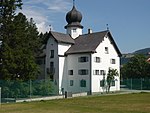The Grisons (, French: [ɡʁizɔ̃]) or Graubünden (German: [ɡraʊˈbʏndn̩] ), more formally the Canton of the Grisons or the Canton of Graubünden, is one of the twenty-six cantons of Switzerland. It has eleven districts, and its capital is Chur. The German name of the canton, Graubünden, translates as the "Grey Leagues", referring to the canton's origin in three local alliances, the Three Leagues. The other native names also refer to the Grey League: Grischùn in Sutsilvan, Grischun in the other forms of Romansh, and Grigioni in Italian. Rhaetia is the Latin name for the area. The Alpine ibex is the canton's heraldic symbol.
The largest and easternmost canton of Switzerland, it is also one of the three large southern Alpine cantons, along with Valais and Ticino. It is the most diverse canton in terms of natural and cultural geography, as it encompasses both sides of the Alps and several natural and cultural regions. The diversity of the canton is often compared to that of Switzerland as a whole and warrants it the name of "Little Switzerland". The Grisons is bordered by four cantons as well as Austria, Italy and Liechtenstein.
The state is the only trilingual canton of Switzerland. It is also the only one where Romansh, Switzerland's fourth national language, has official status. Romansh language and culture is an important part of local identity. In 2020 the canton had a population of 200,096. It is the least densely populated canton of Switzerland. The only sizable city in the canton is Chur, as the majority of the population lives in mountainous areas, including some of the most remote valleys of the country. One of the birthplaces of winter sports, the canton is a major tourist destination year-round, including a large number of Alpine resort towns, notably Davos and St. Moritz. The canton is also renowned for its extensive narrow-gauge railway network, operated by the Rhaetian Railway, and linking the capital with most valleys of the Grisons.
Formerly occupied by the Rhaeti, most of the lands of the canton became part of the Roman province called Raetia, which was established in 15 BC, with Curia, a settlement dating back to the Pfyn culture, as capital city. The area later became part of the lands of the diocese of Chur. The late middle ages saw the foundation of the League of God's House, the Grey League and the League of the Ten Jurisdictions. In 1471 an alliance gave birth to the Three Leagues, and before the end of the 15th century, the latter became an ally of the Old Swiss Confederacy. In 1803 the Three Leagues finally became one of the cantons of the Confederation.










